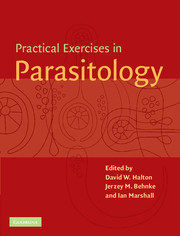Book contents
- Frontmatter
- Contents
- List of contributors
- Preface
- General advice
- 1 Observational Exercises on Parasites
- 2 Ecology
- 3 Physiology and Biochemistry
- 4 Pathology and Immunology
- 4.1 Encapsulation of foreign matter (not-self) by earthworms
- 4.2 Opsonisation of trypanosomes
- 4.3 Production and screening of monoclonal antibodies against Leishmania promastigotes
- 4.4 Pathological effects of Mesocestoides corti and Schistosoma mansoni
- 4.5 Quantification of lymphocyte populations in the spleen and thymus
- 4.6 Use of basic indirect ELISA for the detection of antibodies produced by experimental immunisation
- 4.7 SDS PAGE and Western blotting for the detection of antibodies produced by experimental immunisation
- 5 Chemotherapy
- 6 Molecular Parasitology
- 7 Behaviour
- Appendix 1 Reagent index
- Appendix 2 UK suppliers
- Appendix 3 US suppliers
- Index
4.3 - Production and screening of monoclonal antibodies against Leishmania promastigotes
Published online by Cambridge University Press: 05 June 2012
- Frontmatter
- Contents
- List of contributors
- Preface
- General advice
- 1 Observational Exercises on Parasites
- 2 Ecology
- 3 Physiology and Biochemistry
- 4 Pathology and Immunology
- 4.1 Encapsulation of foreign matter (not-self) by earthworms
- 4.2 Opsonisation of trypanosomes
- 4.3 Production and screening of monoclonal antibodies against Leishmania promastigotes
- 4.4 Pathological effects of Mesocestoides corti and Schistosoma mansoni
- 4.5 Quantification of lymphocyte populations in the spleen and thymus
- 4.6 Use of basic indirect ELISA for the detection of antibodies produced by experimental immunisation
- 4.7 SDS PAGE and Western blotting for the detection of antibodies produced by experimental immunisation
- 5 Chemotherapy
- 6 Molecular Parasitology
- 7 Behaviour
- Appendix 1 Reagent index
- Appendix 2 UK suppliers
- Appendix 3 US suppliers
- Index
Summary
Aims and objectives
This exercise is designed to demonstrate:
Hybridoma technology, including the isolation of mouse spleen cells.
Hybridization of B-cells and tumour cells.
In vitro cultivation of fused cells.
Screening of monoclonal antibodies produced.
Cloning and cryopreservation of cell lines.
Ideally, the whole procedure consists of five 1-day practicals spread out over a period of 5 weeks (when the student actually performs all the steps of the procedure), but this can be shortened to as few as two 1-day practicals (when the student only performs some of the steps and watches a demonstration of others).
Introduction
Monoclonal antibodies have many research and clinical applications (including the detection, localisation, characterisation and purification of antigen). The technique was first described by Köhler and Milstein (1975), but has since been modified and adapted by others (see reviews by Campbell, 1984; Harlow and Lane, 1988). As a practical, the successful production of a few different monoclonal antibodies is considered a very rewarding experience by most students, but even in situations where no antibodies are actually produced during the practical, the students are given the opportunity to learn a variety of useful techniques (sterile handling of cells and centrifugation, tissue culture, cell fusion, preparation of parasite antigens, performance of ELISA and/or IFAT). In addition to the production of monoclonal antibodies itself, the practical provides the demonstrator with an opportunity to discuss (or demonstrate) immunisation, cell cloning and cryopreservation, antibody isotyping, etc.
- Type
- Chapter
- Information
- Practical Exercises in Parasitology , pp. 255 - 266Publisher: Cambridge University PressPrint publication year: 2001



